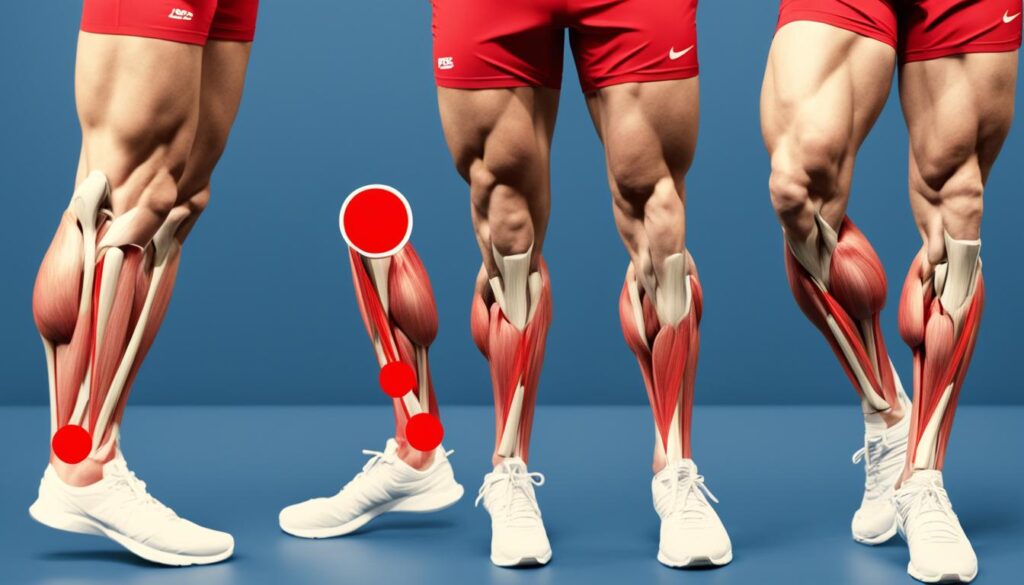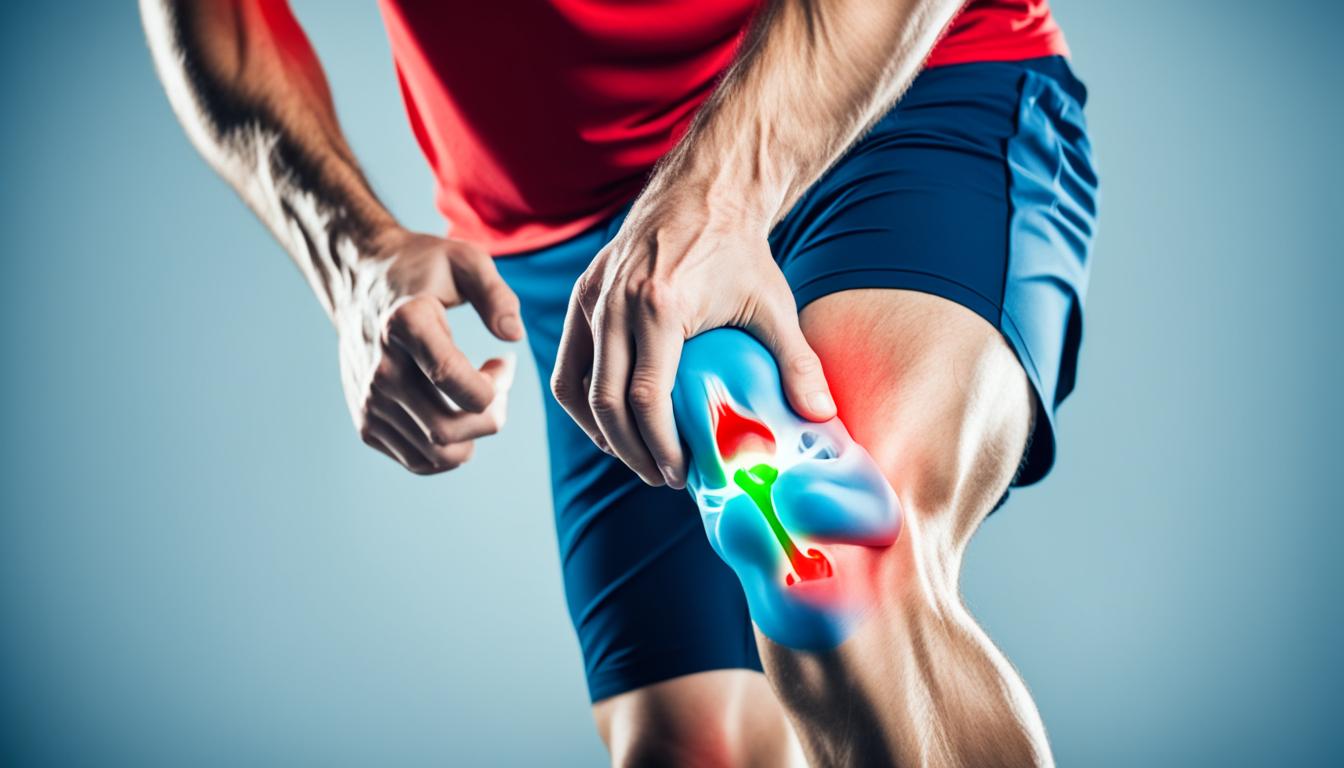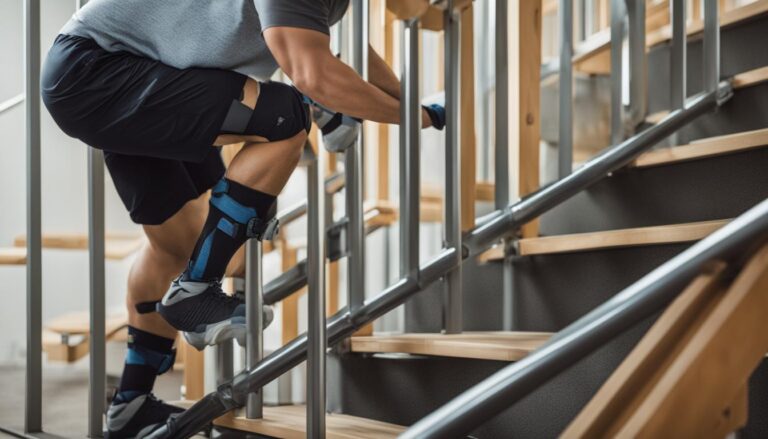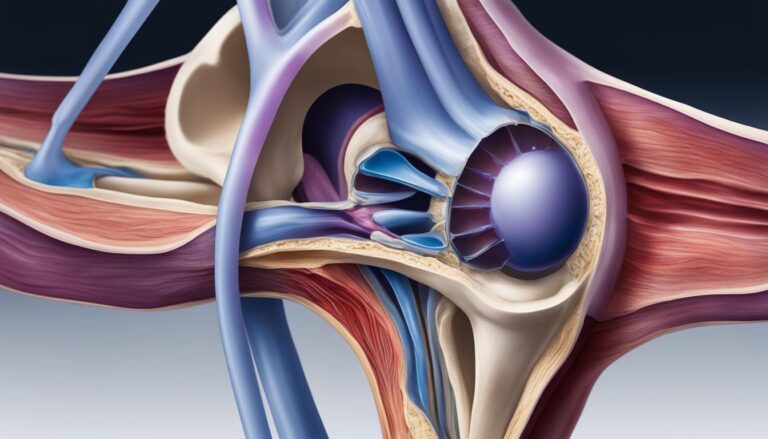Understanding Why Patella Pain Occurs
Did you know that patellofemoral pain syndrome, commonly known as runner’s knee, affects up to 25% of active individuals? That’s a staggering number of people experiencing pain and discomfort in their knees while engaging in various physical activities.
Patellofemoral pain syndrome is characterized by pain at the front of the knee, specifically around the kneecap. It is more prevalent in individuals who participate in running and sports involving running and jumping. The pain can be triggered by activities such as running, walking up or down stairs, sitting for long periods, or squatting.
In this article, we will delve into the causes of patella pain, the role of overuse and muscle imbalances, the impact of injury, the risk factors involved, preventive measures, and the diagnosis and treatment options available. Our goal is to provide you with a comprehensive understanding of patellofemoral pain and empower you to prevent and manage this condition effectively.
So, let’s dive in and uncover the reasons behind patella pain and how you can find relief from this debilitating condition.
The Role of Overuse in Patella Pain
In the realm of patellofemoral pain syndrome, overuse plays a significant role in the development of this condition. Activities that involve running and jumping, such as sports, can subject the knee joint to repeated stress, leading to irritation under the kneecap. This repetitive stress on the knee joint can cause inflammation and pain in the patella region, contributing to patellofemoral pain syndrome.
To prevent overuse injuries and minimize patella pain, it is essential to adopt proper training techniques and gradually increase activity levels. Listening to your body’s signals and not pushing yourself too hard too soon is crucial in maintaining the health of your patella.

Repetitive Stress and Its Impact on Patella Health
Repetitive stress is a key factor in the development of patella pain. When the knee joint is subjected to repeated stress from activities like running and jumping, it can lead to inflammation and irritation under the kneecap, resulting in patellofemoral pain syndrome. The constant pounding and strain on the knee joint can cause wear and tear, leading to overuse injuries and patella pain.
Repetitive stress on the knee joint from activities such as running can cause inflammation and irritation under the kneecap.
Incorporating rest days into your training routine and engaging in low-impact activities can help alleviate stress on the knee joint and reduce the risk of developing patellofemoral pain. It is crucial to strike a balance between challenging your body and allowing it to rest and recover.
Preventing Overuse Injuries and Patella Pain
To prevent overuse injuries and minimize the risk of patella pain, it is important to follow these preventive measures:
- Gradually increase the intensity and duration of your workouts to allow your body to adapt to the demands placed on it.
- Include proper warm-up and cool-down routines in your exercise regimen to prepare your muscles and joints for activity and promote efficient recovery.
- Listen to your body’s signals and take rest days when needed to prevent overloading the knee joint.
- Incorporate cross-training activities that are less stressful on the knees, such as swimming or cycling, to reduce the repetitive impact on your joints.
- Wear appropriate footwear that provides adequate support and cushioning for your feet and knees.
By adopting these preventive measures, you can reduce the risk of overuse injuries and patella pain, allowing you to remain active and pain-free.
Muscle Imbalances and Weaknesses
Muscle imbalances and weaknesses are important factors to consider when addressing patellofemoral pain. In particular, the quadriceps and the muscles around the hip and knee play a key role in knee stability and patella alignment.
When these muscles are imbalanced or weak, they fail to adequately support the knee joint, leading to patella misalignment and subsequent pain. For example, if the quadriceps are stronger on one side of the knee than the other, it can cause the kneecap to track incorrectly.
Addressing these muscle imbalances and weaknesses is essential for preventing and managing patellofemoral pain. Strengthening the key muscle groups, such as the quadriceps, hamstrings, and glutes, can help improve knee stability and patella alignment.
The Role of Quadriceps Strength
Strong quadriceps muscles are crucial for maintaining proper knee alignment and preventing patella pain. These muscles, located at the front of the thigh, provide stability and support to the knee joint. When the quadriceps are weak, the kneecap is more likely to move out of alignment, causing pain and discomfort.
A study conducted by Wang et al. found that individuals with weaker quadriceps muscles were at a higher risk of developing patellofemoral pain syndrome. Furthermore, a review by Witvrouw et al. highlighted the importance of quadriceps strengthening exercises in both preventing and treating patellofemoral pain.
| Quadriceps Strengthening Exercises | Description |
|---|---|
| Lunges | Stand with one leg forward and one leg back, then lower your body by bending your knees. Return to the starting position and repeat on the other side. |
| Squats | Stand with your feet shoulder-width apart, then lower your body down as if sitting back into a chair. Return to the starting position and repeat. |
| Step-ups | Step up onto a raised platform with one leg, then step back down. Repeat with the other leg. |
The Importance of Hip and Knee Alignment
In addition to quadriceps strength, proper alignment of the hip and knee joints is crucial for preventing patellofemoral pain. When the knee collapses inward during activities like squatting or running, it can put excessive stress on the patella and lead to pain and dysfunction.
“Maintaining proper hip and knee alignment is essential for optimal knee function and injury prevention.” – Dr. Sarah Johnson
Strengthening the hip abductor and external rotator muscles can help maintain better alignment and reduce the risk of patellofemoral pain. Exercises such as lateral leg raises, clamshells, and glute bridges target these muscles and improve hip stability.
| Hip Strengthening Exercises | Description |
|---|---|
| Lateral Leg Raises | Lie on your side with your legs stacked. Lift the top leg upward, keeping it straight. Lower back down and repeat on the other side. |
| Clamshells | Lie on your side with your hips and knees bent. Keeping your feet together, lift the top knee as far as you can without rotating your hips. Lower back down and repeat on the other side. |
| Glute Bridges | Lie on your back with your knees bent and feet flat on the ground. Lift your hips upward, squeezing your glutes, and then lower back down. |
By focusing on strengthening the quadriceps and improving hip and knee alignment, individuals can address muscle imbalances and weaknesses that contribute to patellofemoral pain. These exercises, performed regularly and with proper form, can help maintain knee stability, patella alignment, and prevent the onset or recurrence of patella pain.

The Impact of Injury on Patella Health
Trauma to the kneecap can have a significant impact on its health, leading to conditions such as patellofemoral pain syndrome. Injuries like patella dislocation or fractures can cause the kneecap to get out of place or break, resulting in patella pain and discomfort.
Patella dislocation occurs when the kneecap moves or slides out of its normal position, often caused by a forceful impact or sudden change in direction. This displacement can cause severe pain, swelling, and instability in the knee joint. Similarly, patella fractures involve a break in the kneecap bone, resulting in intense pain, bruising, and difficulty moving the knee.
Knee surgery, especially procedures that utilize the patient’s own patellar tendon as a graft in anterior cruciate ligament repair, can also contribute to patellofemoral pain. These surgical interventions, while necessary for treating certain knee conditions, can disrupt the natural stability and alignment of the patella, leading to persistent pain and discomfort.
To minimize the likelihood of developing patella pain, it is essential to take appropriate preventive measures and engage in timely treatment for patella injuries. Utilizing proper protective gear and equipment during physical activities can help reduce the risk of knee trauma. Additionally, seeking professional medical attention and rehabilitation after an injury can facilitate proper healing and recovery.
It is important to note that the severity and long-term impact of patella injuries can vary. Some individuals may experience mild discomfort and recover fully with conservative treatment, while others may require more extensive interventions, such as surgery or physical therapy, to manage their symptoms and regain optimal knee function.
Key Points:
- Trauma to the kneecap, such as patella dislocation or fractures, can cause patella pain and discomfort.
- Knee surgery, especially procedures involving the use of the patellar tendon, increases the risk of developing patellofemoral pain.
- Preventing and treating patella injuries appropriately is crucial to minimizing the likelihood of developing patella pain.
Understanding the Risk Factors for Patella Pain
Several risk factors can increase an individual’s likelihood of developing patellofemoral pain. Age and sex play significant roles in the occurrence of patella pain. Teenagers and young adults are more prone to experiencing patellofemoral pain, while women have a higher prevalence compared to men.
Women’s wider pelvises contribute to the increased angle at which the bones in the knee joint meet, leading to a higher risk of patella pain. Engaging in certain sports that involve running and jumping can further strain the knees, increasing the susceptibility to developing patellofemoral pain.
| Risk Factors | Description |
|---|---|
| Age | Teenagers and young adults are commonly affected by patella pain. |
| Sex | Women have a higher prevalence of patellofemoral pain compared to men. |
| Engaging in certain sports | Participating in sports involving running and jumping increases the risk of patella pain. |
Preventive Measures for Patella Pain
While knee pain can sometimes be unavoidable, there are steps that can be taken to prevent or lessen the likelihood of developing patellofemoral pain. Building strength in the leg and hip muscles helps maintain knee balance during activity. Avoiding deep squatting during weight training is advised. Moving safely with proper techniques, especially focusing on strengthening outer hip muscles, can help prevent the knee from caving inward during activities like squatting, jumping, or stepping down. Losing excess weight, warming up before exercise, practicing stretching exercises for flexibility, and gradually increasing workout intensity are also preventive measures for patella pain.
By following these preventive measures, individuals can significantly reduce their risk of developing patella pain. Let’s dive into each measure in more detail:
1. Building Strength in the Leg and Hip Muscles
Strong leg and hip muscles play a crucial role in maintaining knee stability and reducing the strain on the patellofemoral joint. It is essential to incorporate exercises that target these muscle groups into your regular fitness routine. Examples of effective exercises include squats, lunges, leg presses, and hip abduction exercises.
2. Avoiding Deep Squatting during Weight Training
Deep squatting puts excessive stress on the patellofemoral joint and can exacerbate existing patella pain or lead to its development. Avoid deep squatting during weight training and focus instead on performing partial squats within a pain-free range of motion.
3. Moving Safely and Using Proper Techniques
Proper movement techniques during physical activities are crucial for preventing patella pain. For instance, when performing squats or lunges, it’s important to engage the outer hip muscles and avoid letting the knees cave inward. Consulting with a fitness professional or physical therapist can be helpful in learning the correct form and technique.
4. Losing Excess Weight
Excess weight can place additional stress on the patellofemoral joint and increase the risk of developing patella pain. Maintaining a healthy weight through a balanced diet and regular exercise can help alleviate pressure on the knee joint and reduce the likelihood of experiencing patellofemoral pain.
5. Warming Up and Stretching
Prior to engaging in any physical activity, it’s crucial to warm up properly to increase blood flow, elevate core body temperature, and loosen up the muscles. Warming up prepares the body for exercise and helps prevent injuries. Additionally, incorporating stretching exercises into your routine can improve flexibility and reduce the risk of muscle imbalances that contribute to patellofemoral pain.
6. Gradually Increasing Workout Intensity
When increasing the intensity or duration of your workouts, it’s important to do so gradually. Rapidly intensifying your exercise routine can overload the patellofemoral joint, leading to pain and potential injury. Gradually increasing intensity allows your body to adapt and build strength without placing excessive stress on the knee joint.
By adopting these preventive measures for patella pain, individuals can reduce the risk and severity of patellofemoral pain syndrome. Taking care of your knees and following these guidelines will contribute to maintaining a healthy and pain-free lifestyle.
Diagnosing and Treating Patella Pain
Proper diagnosis and treatment are essential for managing patellofemoral pain. At our healthcare facility, we employ comprehensive methods to accurately diagnose the underlying causes of patella pain. Through a thorough physical examination, we assess the functionality and alignment of the knee joint. We also evaluate symptoms reported by patients, such as pain intensity, location, and aggravating factors.
In addition to the physical examination, we may recommend imaging tests such as x-rays or MRI scans to further assess the condition. These tests provide detailed information about the structures of the knee, helping us identify any abnormalities or damage that could be causing the patella pain.
Once the diagnosis is confirmed, we develop personalized treatment plans to address the specific needs of each individual. Treatment options for patella pain vary depending on the severity of the condition, but most cases can be effectively managed without the need for surgery.
For nonsurgical management, we typically advise activity changes to reduce stress on the knee joint. This may involve modifications to exercise routines, avoiding high-impact activities, or implementing periods of rest to allow for recovery and pain relief.
Ice packs and compression knee wraps can help reduce inflammation and provide temporary relief from pain. We may also recommend over-the-counter or prescription anti-inflammatory medications to alleviate discomfort.
Stretching exercises for the muscles around the knee, as well as strengthening exercises for the quadriceps and hips, can improve knee stability and support overall patella alignment. Physical therapy sessions with our experienced therapists may be recommended to optimize range of motion, strength, and endurance.
“Our goal is to provide comprehensive and effective treatment options for patella pain, helping our patients regain function and improve their quality of life.”
In some cases, orthotics or shoe inserts may be prescribed to provide additional support to the foot and ankle, reducing stress on the knees.
When necessary, we collaborate with orthopedic specialists to determine if surgical intervention is the best course of action. However, our primary focus is always on conservative, nonsurgical approaches to manage patella pain, ensuring that patients can recover and resume their normal activities as soon as possible.
Diagnosing and Treating Patella Pain: Summary
Properly diagnosing patellofemoral pain syndrome is a crucial step in effectively treating and managing the condition. Our healthcare professionals conduct physical examinations and utilize imaging tests to accurately identify the causes of patella pain. Through personalized treatment plans, we employ nonsurgical approaches such as activity changes, rest, ice packs, compression knee wraps, anti-inflammatory medication, stretching exercises, and strengthening exercises. Physical therapy and the use of orthotics or shoe inserts may also enhance recovery and provide long-term relief from patella pain.
Conclusion
In conclusion, patellofemoral pain is a common condition that often affects individuals who engage in activities such as running and jumping. It is essential to understand the causes and risk factors associated with patella pain to effectively prevent and manage this condition.
By implementing preventive measures such as building strength, moving safely, losing weight, warming up, stretching, and gradually increasing workouts, individuals can significantly reduce their likelihood of developing patellofemoral pain. These proactive steps can help maintain knee balance, prevent muscle imbalances, and avoid overuse injuries.
For individuals already experiencing patella pain, proper diagnosis and treatment are key. Activity changes, rest, ice, medication, and physical therapy can help alleviate pain, improve function, and facilitate recovery. It is also essential to pay attention to any structural problems or contributing factors that may require additional medical interventions.
By staying proactive in preventing patella pain and seeking appropriate treatment when needed, individuals can minimize the impact of patellofemoral pain on their daily lives and maintain optimal knee health.
FAQ
Why does patella pain occur?
Patella pain can occur due to various reasons, such as overuse, muscle imbalances, injury, and surgery. Repetitive stress on the knee joint, muscle weaknesses, trauma to the kneecap, and certain risk factors can contribute to the development of patellofemoral pain syndrome.
What are the causes of patella pain?
Patella pain can be caused by overuse injuries, muscle imbalances or weaknesses, trauma to the kneecap, and certain risk factors like age, sex, and participating in specific sports. Understanding the underlying causes is crucial for prevention and management of patella pain.
What triggers patella pain?
Patella pain can be triggered by activities such as running, walking up or down stairs, sitting for long periods, and squatting. These activities can aggravate the pain and discomfort experienced in the front of the knee, around the kneecap.
How do muscle imbalances or weaknesses contribute to patella pain?
When the muscles around the hip and knee, particularly the quadriceps, are imbalanced or weak, they fail to keep the kneecap properly aligned. This misalignment can result in patellofemoral pain syndrome and contribute to patella pain. Strengthening these muscles and maintaining proper knee alignment can help prevent and manage patella pain.
What are the causes of patella injuries?
Patella injuries can be caused by trauma to the kneecap, such as dislocation or fractures. Additionally, knee surgery, particularly the use of one’s own patellar tendon as a graft in anterior cruciate ligament repair, increases the risk of patellofemoral pain. Appropriate prevention and treatment methods are essential to minimize the likelihood of developing patella pain.
What are the risk factors for developing patella pain?
Age, sex, and participating in certain sports that involve running and jumping are risk factors for developing patellofemoral pain. Teenagers and young adults are more likely to experience patella pain, and women are twice as likely as men to develop the condition. Engaging in activities that add extra stress on the knees can also increase the risk.
How can patella pain be prevented?
Preventive measures for patella pain include building strength in the leg and hip muscles, moving safely with proper techniques, losing excess weight, warming up before exercise, practicing stretching exercises for flexibility, and gradually increasing workout intensity. These measures help maintain knee balance, prevent muscle imbalances, and minimize the risk of developing patellofemoral pain.
How is patella pain diagnosed and treated?
Healthcare providers can diagnose patellofemoral pain through physical examination, evaluation of symptoms, and imaging tests like x-rays or MRI scans. Treatment options vary but often involve nonsurgical approaches such as activity changes, rest, ice packs, compression knee wraps, anti-inflammatory medication, stretching exercises, and strengthening exercises. In some cases, physical therapy or orthotics may be recommended.






